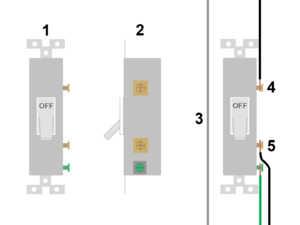Switch
Jump to navigation
Jump to search


A common switch design
(1) Front view of the switch without a cover. (2) Side view of the switch without a cover. (3) Circuit conductor that doesn't pass through the switch (grounded conductor, neutral). (4) Circuit conductor controlled by the switch - connected and disconnected - that is wired to a light or outlet. (5) Incoming live (ungrounded) conductor.
(1) Front view of the switch without a cover. (2) Side view of the switch without a cover. (3) Circuit conductor that doesn't pass through the switch (grounded conductor, neutral). (4) Circuit conductor controlled by the switch - connected and disconnected - that is wired to a light or outlet. (5) Incoming live (ungrounded) conductor.
Switches are used to safely turn on and off AC and DC circuits. This can be useful for not only lighting, but also to switch off appliances that remain continuously plugged in. Switch designs vary between countries, but the overall concept remains the same for most residential circuits: a switch opens and closes the ungrounded conductor of a circuit to determine whether there is a complete circuit or not. The other conductor of a circuit is not switched, it is only necessary to switch one conductor as this breaks the circuit. As switch designs vary between countries, the proper method for wiring and installing switches will vary.
For examples of how to wire basic load circuits see - Wiring basic load circuits.
Considerations
- One switch can easily be wired to switch multiple lights or outlets.
- Switches should always be installed in a junction box or other type of enclosure to ensure that all live metal parts are protected. If they are going to be installed outdoors, they must be installed in an enclosure made for outdoor use.
- If a system has an AC system ground then an equipment ground must be run to each switch, light, or outlet for user safety.
- Connecting stranded wire to some types of outlets must be done very carefully to create a proper connection with no stray strands of wire.
- Ensure that all wires are properly attached to the switch by tugging on them gently after tightening the screws on the switch.